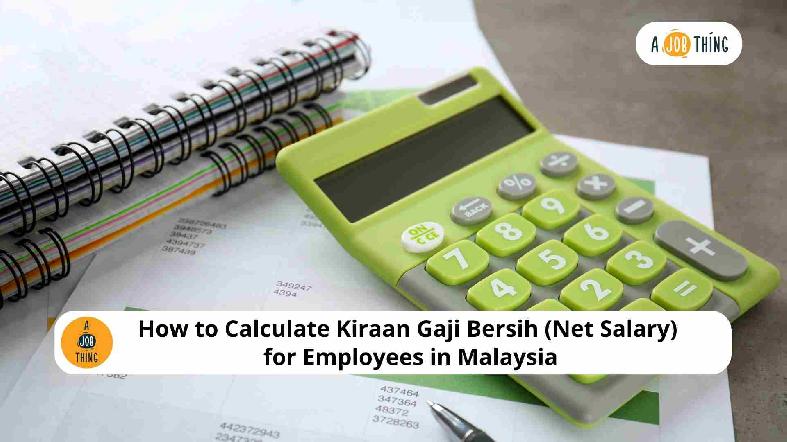
How to Calculate Kiraan Gaji Bersih (Net Salary) for Employees in Malaysia
Are You Hiring?
Find candidates in 72 Hours with 5+ million talents in Maukerja Malaysia & Ricebowl using Job Ads.
Hire NowWhen payday comes, the first thing employees look at is their net salary, or take-home pay. If the amount looks different from what they expect, HR will likely be the first to get questions.
That’s why, as an HR professional, you need to know how to calculate net salary in Malaysia and understand the standard deductions involved. This article will guide you through it.
What Is Gaji Bersih (Net Salary)?
Gaji bersih refers to the amount an employee receives in their bank account every month after all required deductions are made. This includes statutory contributions such as EPF, SOCSO, and EIS, as well as income tax deductions through PCB (Potongan Cukai Bulanan). It can also include company-specific deductions such as loan repayments or canteen fees.
On the other hand, gaji kasar or gross salary is the total monthly pay stated in the offer letter. It includes the basic salary, fixed allowances, commissions, and overtime before any deductions.
For example, if an employee’s gaji kasar is RM3,000, their gaji bersih may end up around RM2,400–RM2,500, depending on the statutory deductions and their tax profile.
Standard Deductions in Malaysia
To calculate net salary accurately, employers must deduct the following items from gross salary:
EPF (KWSP)
The Employees Provident Fund (KWSP) is a mandatory retirement savings scheme. Most employees under the age of 60 contribute 11% of their monthly salary, while employers contribute a separate amount. Some schemes or age brackets may have a different rate.
SOCSO (PERKESO)
SOCSO provides insurance for workplace injuries and death. The contribution depends on the employee’s salary tier and age. Both the employer and the employee contribute, but the percentage varies.
EIS (SIP)
The Employment Insurance System (SIP), also managed by PERKESO, provides support for workers who lose their jobs. The employee share is fixed at 0.2% of monthly wages.
PCB (Potongan Cukai Bulanan)
PCB is the employee’s monthly income tax deduction, paid to LHDN. It applies to employees earning RM2,851 or more per month, or RM3,851 for married couples. PCB helps employees pay tax gradually throughout the year. The rate depends on income, marital status, and any declared tax reliefs.
Other Deductions
These may include:
-
Zakat (if applicable, for Muslim employees with income above the threshold)
-
Advance salary repayments
-
Staff loans
-
Charges like parking or food if provided by the company
Why Net Salary Calculation Matters to Employers
Getting the kiraan gaji bersih right affects almost every aspect of your HR operations.
First, accurate deductions help the company follow EPF, SOCSO, EIS, and LHDN rules. Failure to comply can lead to penalties or audits.
Second, it helps prevent friction with employees. If someone sees a different number on their payslip than expected, it often leads to confusion or complaints. A transparent breakdown of deductions builds trust and makes it easier for employees to plan their finances.
From a budgeting perspective, understanding net salary is essential when estimating HR costs. It also helps during loan support letters or when issuing EA forms for income tax filing.
How to Calculate Gaji Bersih
The basic formula is:
Gaji Bersih = Gaji Kasar – (EPF + SOCSO + EIS + PCB + Other Deductions)
To make this process easier and more accurate, many employers use payroll software or tools like LHDN’s PCB calculator or PayrollPanda’s gaji bersih calculator.
Let’s say an employee earns RM3,000 (gaji pokok) and gets a fixed allowance of RM500. Their gaji kasar is RM3,500. From this:
-
EPF (11%) = RM385
-
SOCSO = around RM19
-
EIS = RM7
-
PCB = varies by profile (for this example, let’s say RM60)
So, their estimated gaji bersih is:
RM3,500 – (RM385 + RM19 + RM7 + RM60) = RM3,029
This is the amount that should be credited into their bank account every month.
Scenarios Where This Is Important
Understanding net salary matters in several situations below:
-
During hiring: When discussing salary offers with candidates, it's useful to explain the expected take-home amount after deductions.
-
Payslip transparency: A clear payslip builds trust and reduces confusion.
-
Tax season: Before issuing EA forms, HR needs to confirm that all monthly PCB deductions were correctly calculated.
-
Employee queries: When staff ask about deductions, you need to explain what each figure means.
-
Planning bonuses or incentives: Helps you predict the actual amount received by the employee.
Tips for Employers
To maintain smooth and transparent payroll operations:
-
Always provide a full breakdown of deductions in every payslip.
-
Use updated deduction tables from EPF, SOCSO, EIS, and LHDN.
-
Equip employees with access to tools or calculators so they can check their expected gaji bersih.
-
Make sure your payroll staff are trained in how to compute each statutory deduction accurately and according to the latest guidelines.
Need to Hire New Employees in Malaysia?
Post your job ads on Maukerja, Ricebowl, Epicareer with AJobThing to find the best talent today!
Read More:
- How to Calculate Salary Per Day in Malaysia
- Latest Gaji Minimum Malaysia in 2025 for HR and Business Owners
- Average Salary in Malaysia 2025: Industry & Job Role Insights
- Salary Calculator for Employers in Malaysia [+FREE Template]
- Free KWSP/EPF Calculator Excel Template for Malaysian Employers
- How to Prepare a Monthly Salary Report in Malaysia (+ Free Templates)
- Salary Schedule (Jadual Gaji) in Malaysia: When to Pay & Pay Dates
- Salary Increase Calculator: How to Calculate & Free Excel Template

